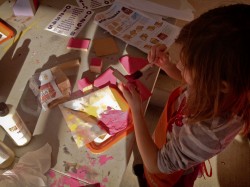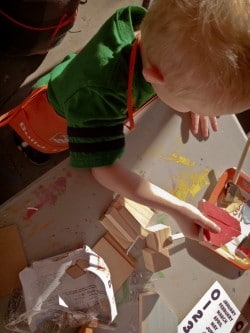The joy of painting is best understood through the eye and hearts of children.
Advertisement


String Painting
String painting is straightforward and is a smart way for youngsters to pattern paint. You simply wrap some string around a small wooden block (this may very well be a building block that your kids play with). A square or rectangle shape is best, however ensure that it’s large enough for the child to hold easily. To help in your kid’s learning, it’s best to have a number of completely different sizes handy. Prepare some paint and pour it into some old polystyrene trays or any tray that you can afford to use for lots of painting activities. Dip the block into the paint and press on the paper. Make any patters you like and use as many colors you like and viola, you’re finished!
Marble Painting

Will Hull,
Windy Pinwheel
Marble painting is another method for children to have fun and also build their hand eye coordination skills while creating completely different patterns. Prepare some paint and put it in a container that has deep sides, such as an old baking tray or a shallow cardboard box. The top of a shoe box is a wonderful example, provided that it’s still sturdy and intact. Put some paper in the bottom of the tray with a small quantity of paint (you can use two or three different colors at a time). Drop a marble in the tray and let the kids move the marble backwards and forwards, sideways and so on, to create their very own work of art.
Finger Painting
Finger painting develops a child’s sensory skills as they feel and touch the paint. Put some paint on an old table and let the kids put their fingers in it and make their very own designs. If you don’t have an old table that you can use, then you may always put some plastic on the table and this will suffice.

Please keep in mind that you should use paints are easily washed off surfaces and fingers with hot soapy water and read the label on the paint you are using with your children to be sure. Once the children have completed their painting, put a piece of paper on top and peel it off. Put it somewhere to dry after which they have a print of their artwork work to display around the house.
Here are some other fast ideas and alternate options that your children might take pleasure in that may also be used for printing…
Cotton, Sponges and Cardboard
- Cotton ball painting can encourage kids to paint in a completely different way, which develops fantastic motor skills.
- Cotton wool has a completely different feel and texture to it.
- Paint rollers are fun to use on large rectangular areas. So this may be excellent for instance, if you’re planning on painting a cardboard fort or large surface areaa.
- Cotton reels and corks can be used for pattern painting.
- Sponges cut into different shapes might be a good way to recycle and you can use each their rough and smooth sides in painting. Some examples of shapes you can use are rectangles and circles and a diamond or star. You can also buy sponge shapes from a good toy or art supply store, or you can order them from educational supply magazines as well.
- Other ideas include the cardboard rolls inside household foil and plastic wrap or wrapping paper tubes after you’re finished with the wrapping paper, plastic forks or jar lids.
Just remember, its not out the outcome but the process and experience getting there. So let those artistic juices flow and the minds of your children will expand with a newfound appreciation for art.
What kind of household items do you use with your children when it it time for them to put down their technology devices like an iPad or turn off the TV? Please share your experience and thoughts with us.
